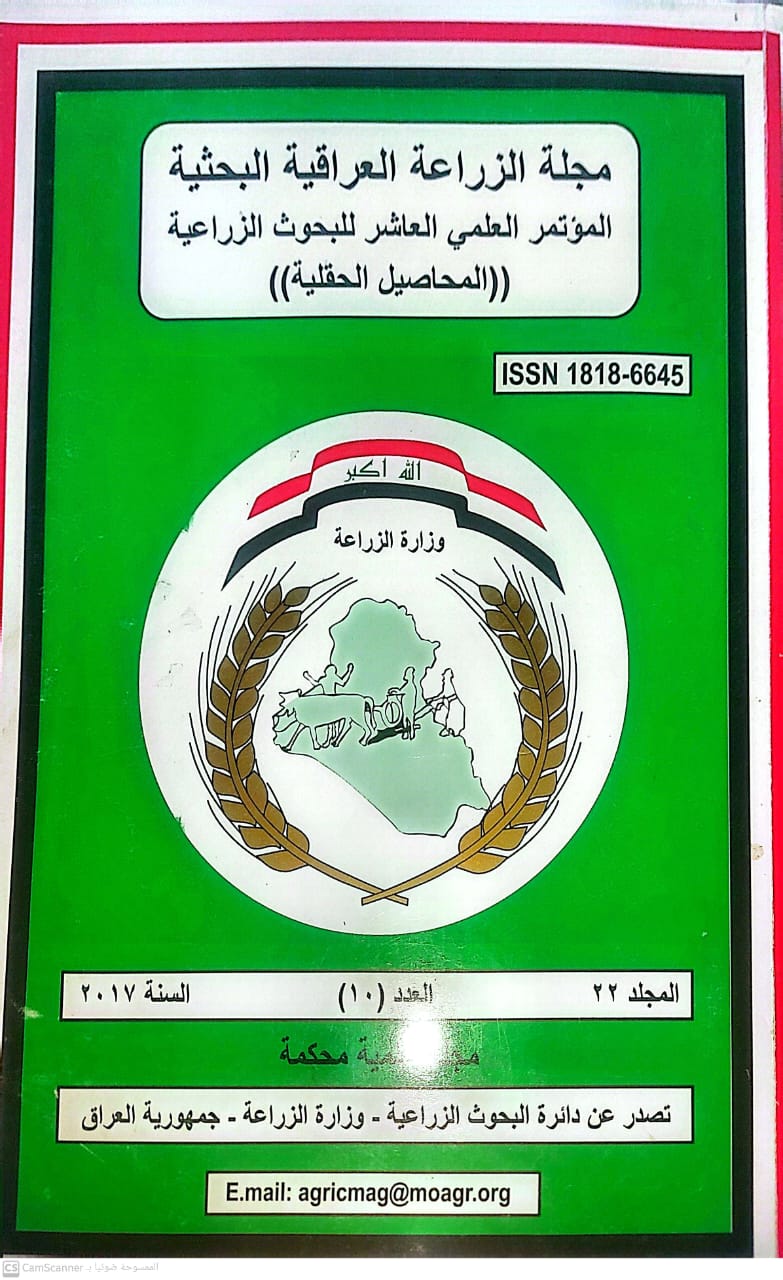Abstract
The study was conducted in order to develop spatial distribution map for soil suitability for wheat growing within Abo-Bshot project and to show the relationship between suitability values and wheat yield production. The study area was selected in Abo-Bshot agricultural project in Maysan Government, soils were used for grain crops and some vegetables. The study area covers about 21000 don. Twenty farms were selected in the study area and soil samples were taken from each farm (0-30cm depth) to determine some physical and chemical soil properties. Soil suitability for wheat production was determined by using Sys et al.(1993) system. Wheat yield was determine by using square method and the relationships between wheat yield and soil properties were determined using simple statistical analysis. Temporal differences in the value of NDVI were determined using images of Landsat-8 for OLI sensor-images were taken in 11/11/2015 ,15/2/2016 and 5/3/2016.
The results indicated that the study sites show some differences with in their soil properties mainly in soil texture salinity and organic matter content -Also ,the results indicated that differences in the management practices used by the farmer in the study area including weeds controlling and tillage practices . The result revealed that soil proportion show different suitability values for wheat production. Salinity and organic matter contents are the most limiting factors for wheat suitability production. These are permeant limitation which can be improve by using some suitable management practices. In general soils of the study area are suitable for wheat production and fall within suitability classes of S1 S2 and S3. The results of simple regression analysis show a positive correlation between wheat yield and the content of organic matter and gypsum. While, other soil properties show a negative relation with wheat yield .Also, the results indicated a positive correlation between wheat yield and NDVI values, and there is temporal variation for NDVI in the study area. Wheat yield varies the study area varies between 350 to 1200 Kg/don. with mean of 589.75 Kg/don These variation in wheal yield related mainly with soil properties and some management practice used in the study area. There is a good correlation between the spatial distribution of wheat yield and soil suitability values.
The results indicated that the study sites show some differences with in their soil properties mainly in soil texture salinity and organic matter content -Also ,the results indicated that differences in the management practices used by the farmer in the study area including weeds controlling and tillage practices . The result revealed that soil proportion show different suitability values for wheat production. Salinity and organic matter contents are the most limiting factors for wheat suitability production. These are permeant limitation which can be improve by using some suitable management practices. In general soils of the study area are suitable for wheat production and fall within suitability classes of S1 S2 and S3. The results of simple regression analysis show a positive correlation between wheat yield and the content of organic matter and gypsum. While, other soil properties show a negative relation with wheat yield .Also, the results indicated a positive correlation between wheat yield and NDVI values, and there is temporal variation for NDVI in the study area. Wheat yield varies the study area varies between 350 to 1200 Kg/don. with mean of 589.75 Kg/don These variation in wheal yield related mainly with soil properties and some management practice used in the study area. There is a good correlation between the spatial distribution of wheat yield and soil suitability values.
Abstract
اختيرت منطقة الدراسه في مشروع ابوبشوت - محافظة ميسان لغرض دراسة العوامل الموقعيه ومنها بعض صفات الترب السائدة في المشروع المؤثرة في إنتاجية محصول الحنطة . تم تحديد عشرون موقعاً للفلاحين العاملين في المشروع وحددت مواقعها جغرافياً باستخدام جهاز تحديد المواقع العالمي GPS وثبتت على مرئية فضائية ملتقطة من القمر الاصطناعي الأمريكي Landsat8 للمتحسس OLI الملتقطة بتاريخ 5/3/2016. استخدمت المرئية لحساب دليل الأختلاف النباتي NDVI. أخذت نماذج التربة من آلأفاق السطحية من (0–30 سم) من كل موقع لغرض تقدير بعض من صفات التربة الفيزيائية والكيميائية. تم جمع بعض المعلومات الخاصة بادارة محصول الحنطة في كل موقع ، ثم قدرت غلة المحصول باستخدام طريقة المربعات ولعدد من المكررات. حسبت العلاقة الإحصائية بين الإنتاجية وصفات التربة المدروسة .أظهرت النتائج وجود تباين في صفات التربة وخاصة ألايصالية الكهربائية و صنف النسجة ومحتوى المادة العضوية بين ترب مواقع الدراسة . كما أشارت النتائج الى وجود تباين في الأساليب الإدارية المتبعة من قبل الفلاحين في إدارة محصول الحنطة ومنها مكافحة الإدغال وأساليب الحراثة وكمية السماد المعدني المستخدم. وأوضحت النتائج أن إنتاجية الحقول آلزراعية آلمختارة تتراوح بين 350-1200 كغم/دونم وبمعدل عام مقداره 589.75 كغم/دونم ويعزى هذا إلى حالة التباين في صفات التربة والأساليب الزراعية المتبعة ،إذ أشارت العلاقات الإحصائية إلى وجود علاقة موجبة عالية المعنوية بين الإنتاجية وقيم كل من المحتوى العضوي، ومحتوى الجبس ، كما أبدت صفة الإيصاليه الكهربائية علاقة سالبة عالية المعنوية مع الإنتاجية. لوحظ وجود علاقة موجبة عالية المعنوية بين الإنتاجية وقيم دليل الإختلاف النباتي NDVI . هذا وقد أبدت العمليات الإدارية ومنها عمليات الطربسة ومكافحة الأدغال وكمية السماد عملاً كبيراً في زيادة إنتاجية محصول الحنطة في منطقة الدراسة
